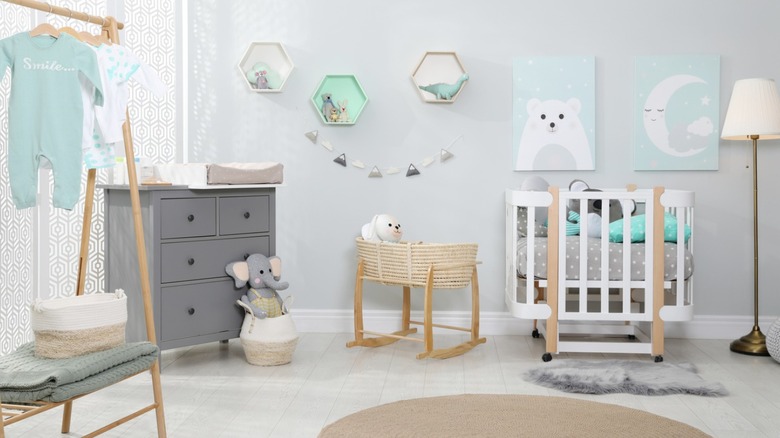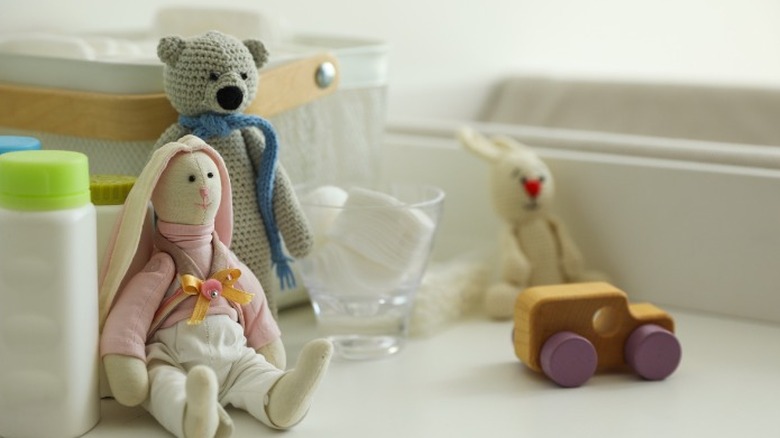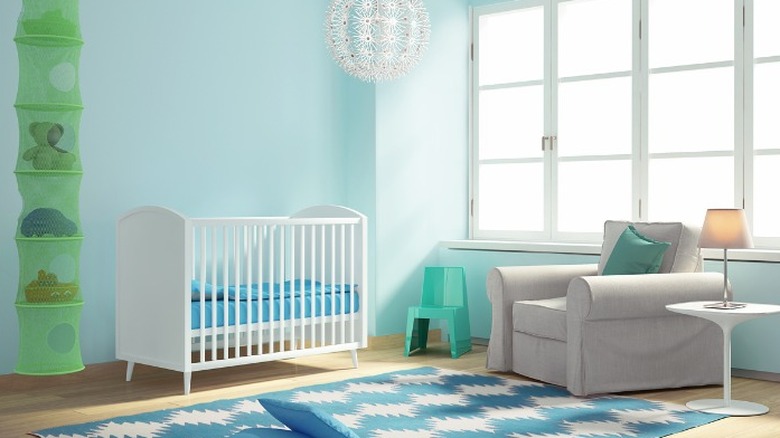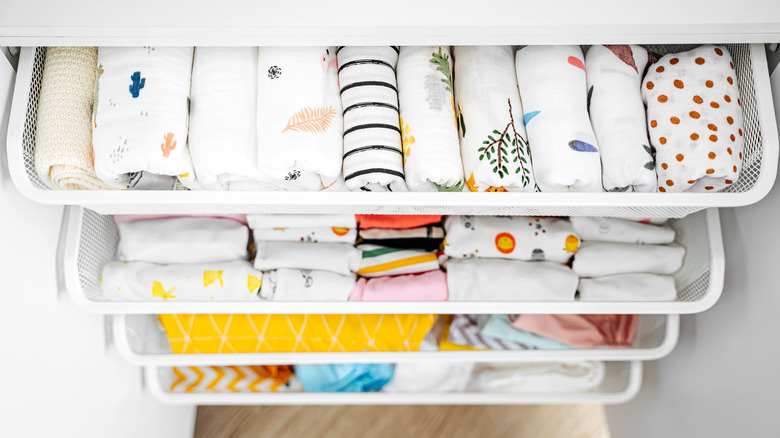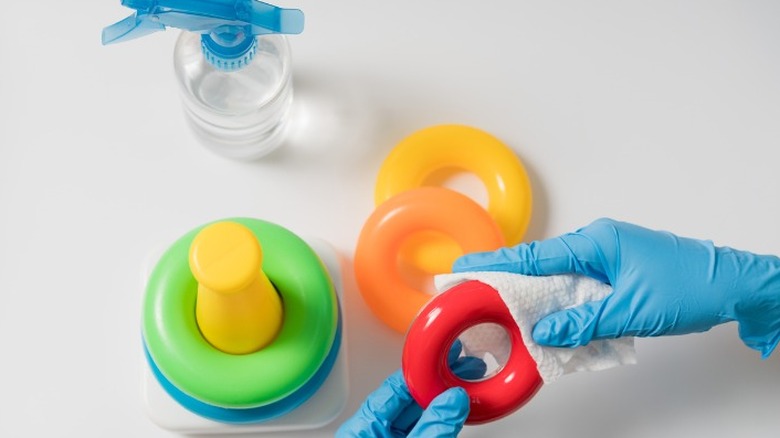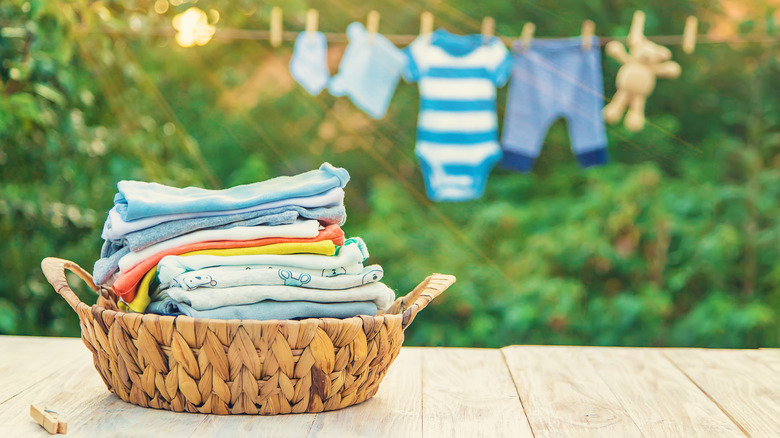5 Simple Tips For Keeping Your Nursery Organized
Whether it's your first, second, or third baby, the nursery needs to be stocked and ready for their arrival. Taking care of a baby is unpredictable and sometimes messy, as it can take a while to establish a routine, so it's imperative to remain organized. Make sure you have the essentials put into place, such as a crib, changing area, hamper, diaper dispenser, and a comfortable rocking chair or couch. Besides furniture, having a baby requires loads of other daily necessities like diapers, wipes, lotions, rash creams, cloths, clothes, and blankets. If you had a baby shower, there could be an abundance of products and materials you've received as well, as some of them can become superfluous.
So, how do you maintain an organized nursery with all these items? From storage bins and shelving to drawer organizers and built-ins, there are plenty of ways to keep structure within your daily and/or nightly routine. According to Two Twenty One, the use of baskets, bins, and drawers are top organization tools not to leave out. Depending on the size of your nursery, you might benefit from a variety of storage options, from through alcove shelving or normally unused space under the crib or changing table. Besides keeping areas orderly, maintaining clean surfaces and laundry is also vital. From late nights to early mornings, lotion mishaps, and diaper explosions, there's a lot to sustain with a baby. Keep reading to discover more ways to keep your nursery in line.
1. Simplify your essentials
With all the baby items we are given, some things might be unnecessary. Instead, have all your baby's essentials on hand while keeping the room simple and tidy with limited amenities, furnishings, and toys. Furniture may be the costliest part of a nursery, as you could spend anywhere from hundreds to thousands of dollars on brand-new pieces that incorporate a chic and modern design, including décor and pricey electronics. According to Baby Chick, diaper disposal containers may also be a needless expense, as containing dirty diapers within the nursery can be highly unsanitary. Other excessive items can also be a wipe warmer, designer clothes, and baby shoes.
Focus on the basics. In the beginning, the changing area is where you'll be a lot. Make sure you have what you need within arm's reach by using a small caddy or basket placed in this area or located above on a shelf. More clutter, more hassle. Diapers, creams, a quick change of clothes, and a hamper nearby are all you really need to start.
2. Establish a functional layout
Whether feeding or singing the baby to sleep, common areas you'll find yourself are at the changing table, in a rocking chair, or over the crib. The placement of these three elements may depend on the design of your nursery room. Whatever the size, it's important to establish a practical design that incorporates each area. Typically, beds and cribs shouldn't be placed near windows. Potential hazards like cords and curtains, including cold air, can either harm or irritate the baby (via Natural Baby Life). Instead, you might position a chair next to the crib or the crib next to the changing area, or the chair near the window. Whatever you decide, keep it simple.
A triangular layout might be most suitable to achieve adequate division between each area, as it creates a common space within the center. You could place a clean area rug or mat here to let the baby stretch and play on. Some walking distance between the areas will provide a more open feel with room to pick things up, change the sheets, and clean the floors. You might install multi-level, built-in shelves within an alcove, armoire, or closet for convenient storage. This system is great for storing hats, booties, shoes, extra and/or seasonal clothes, and jackets. Utilize bins and labeled clothes dividers to keep items especially neat, and keep clothes at eye/arm level so you're not constantly bending down to get fresh ones.
3. Utilize a multi-functional diaper station
Keep it all in one place. Whether you choose a dresser top or changing table for your baby's diapering needs, make sure the piece serves its purpose on multiple levels. This is where you should fully stock your go-to supply of diapers, wipes, clothes, blankets, or other basics. While changing tables are stable and offer open storage for easy access, utilizing a dresser might offer a more elongated function after the baby is past the diaper stage, per Dad Fixes Everything. While a new or vintage dresser provides ample drawer space, make sure to stabilize the changing pad on top with straps or some other adhesive or non-skid mat.
Upon sorting the baby's wardrobe, decide which pieces should be hung and which folded. Within the drawers, you might implement dividers to sort clothes by type or color, although the size might be best, as the baby can grow rather quickly. For example, you could categorize or label each drawer by onesies, jumpsuits, or pajamas while staying within the present size range. Next, fold or tightly roll clothes and other materials to create an organized appearance. If your changing station comes with additional shelves or drawers, then place various blankets, including swaddles, sheets, and other clothes there as well. Storing them towards the bottom might be ideal if some items aren't used or changed out often.
4. Create a cleaning routine
Maintaining a clean atmosphere within your home is fundamental, especially in the baby's room. Daily duties that are greatly required are removing soiled diapers and trash, or wiping down fresh messes or stains within the changing area, so establishing a routine is key to staying attentive. According to Southwest Human Development, you should disinfect toys that your baby has frequently had their mouth on; this could be every day or more, depending on use. Once a week, you can dust shelves, furnishings, and ceiling fans while sweeping, mopping, and/or vacuuming the floor or rug. Attempt a deeper clean once a month by sweeping behind chairs and dressers and dusting inside closets and/or deep nooks, plus wiping down doors and windows. Shake out the curtains as well and wash them if needed.
Often exhausted as a parent, we sometimes find it hard to pick up everything all the time or even occasionally. If the nursery starts to look cluttered and excessive again, clean and sort. Pick up or remove items that may have been left on the floor or fallen under or behind something weeks ago. Cleaning and decluttering with a daily, weekly, and monthly routine will make each day with the baby feel like a fresh start. Finally, if the weather is nice, open the windows often to air out the room.
5. Keep up with the laundry
In addition to yourself, you might notice your baby turns over more laundry than anybody else within your household, especially within the first year. Besides washing and drying blankets, clothes/onesies, diapers (if cloth), rags, and sheets, keeping it all organized is a significant task. With how many fresh and clean linens and clothes a baby requires, you will suffer if something is not there when extremely needed. With some trial and error, determine a schedule that works best for you and your family. You might pick a certain day each week to do the wash, or, if the baby runs out of clothes and other materials more quickly, throw it in each day or night, per Romper. This will keep large loads from accumulating or becoming overwhelming.
With numerous daily changes, including clothes, blankets, sheets, or cloth diapers, establishing a laundry routine will coincide with your nursery's daily flow. For example, you might sort and divide the baby's laundry by color (lights and darks) or material (delicate or heavy), so you can easily put your folded stacks away. Then, as the size of your baby's clothes changes, you can revamp the collection by discarding the outgrown items during this process as well rather than going back to sort them out later.
